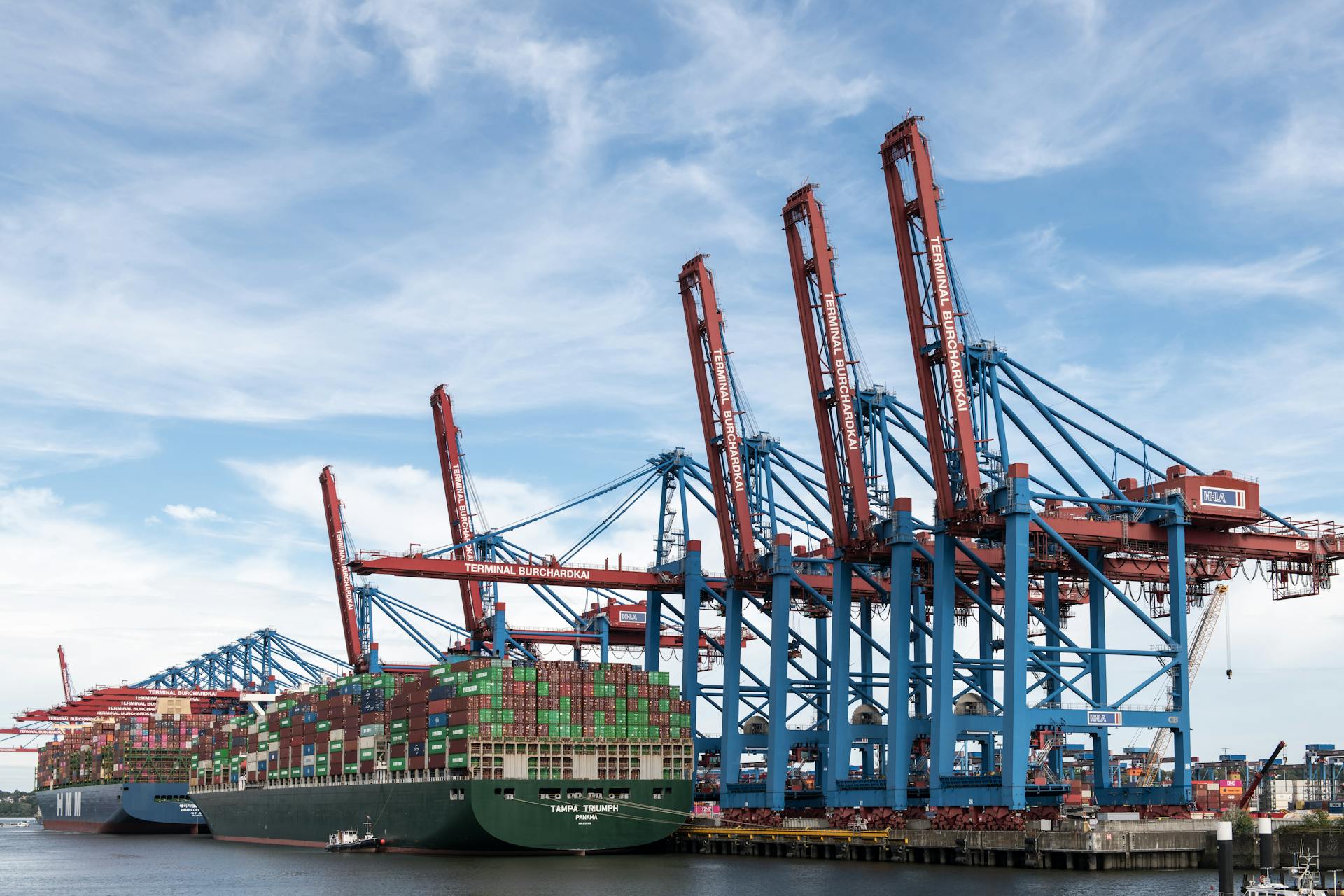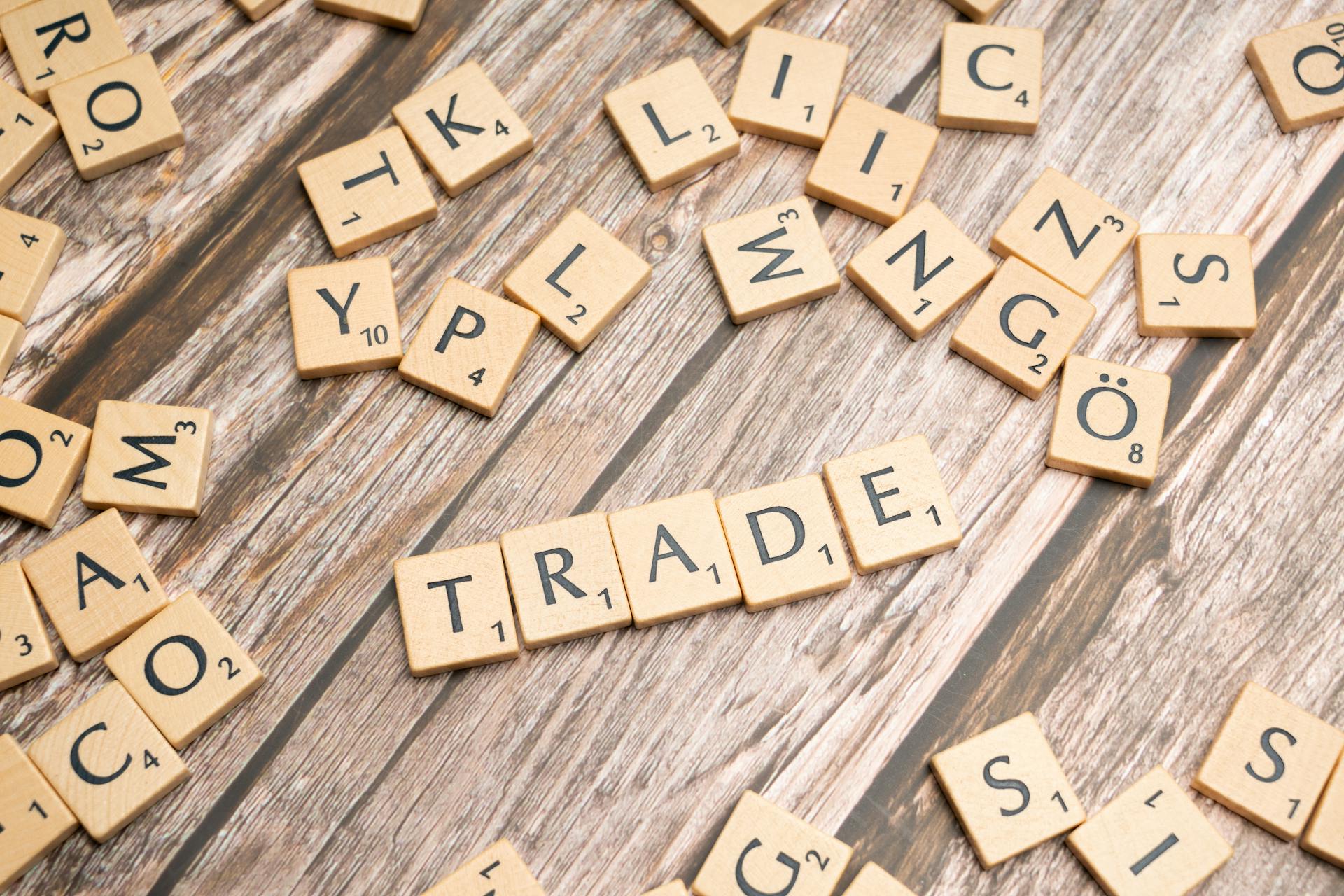
In Canada, importation rights are governed by the Customs Tariff and the Export and Import Permits Act. The Canadian government allows the importation of certain goods, but not others.
The Canadian Border Services Agency (CBSA) is responsible for enforcing the importation regulations. The CBSA has a list of prohibited and restricted goods that cannot be imported into Canada.
Permitted goods include personal effects, gifts, and commercial goods that meet specific requirements. For example, a person can bring a certain amount of personal effects, such as clothing and jewelry, into Canada duty-free.
Some goods, like food and plants, require specific permits and documentation to ensure they meet Canadian standards. The CBSA website provides detailed information on the requirements for importing these types of goods.
Additional reading: Import Tax Canada to Us
Importation Process
The importation process can be complex, but it's essential to get it right to avoid any issues with your shipment.
Certain goods are not allowed to be imported into Canada, such as used mattresses and some used automobiles, so make sure to check the list of prohibited products.
The CBSA is responsible for administering the legislated import requirements on behalf of other government departments, which means you'll need to determine if the goods you want to import are subject to regulations, restrictions, permits, or other requirements.
The CBSA's Other Government Departments and Agencies: Reference List for Importers can help you identify the most commonly imported commodities that may require permits and/or certificates.
If you're importing alcohol or tobacco products, it's recommended that you check with the applicable authority in your province or territory.
The CBSA requires certain goods to be clearly marked with the country of origin, which can be found in Memorandum D11-3-1, Marking of Imported Goods.
Certain goods are subject to measures under the Special Import Measures Act (SIMA), which includes anti-dumping duties, countervailing duties, and undertakings.
Before importing certain goods into Canada, you must determine if they are subject to domestic controls, such as the Defence Production Act (DPA) and the Controlled Goods Regulations.
A full list of controlled items in Canada is available in the Schedule to the DPA, and you can also refer to PWGSC's Guide to the New Schedule to the Defence Production Act for more information.
Understanding Import Regulations
Importation regulations can be complex, but understanding the basics is crucial for anyone looking to import products into the US.
Under United States copyright law, it is technically illegal to import any copyrighted material into the country. However, there are some exceptions that allow for the importation of certain products.
For instance, if you're importing a large quantity of copyrighted material, you can present an import statement issued under the seal of the Copyright Office to the US Customs Service, and they will allow you to import up to 2,000 copies.
Do I Need an Import License?
You'll need to check the requirements of the federal agency or agencies that regulate the product you plan to import. These agencies will have the most up-to-date information on licenses and permits.
Certain goods are not allowed to be imported into Canada, including child pornography, hate propaganda, used mattresses, and some used automobiles. You can find more information on prohibited products in Memoranda Series D9, Prohibited Importations.
To determine if your goods require a permit, check the CBSA's Other Government Departments and Agencies: Reference List for Importers. This list includes some of the most commonly imported commodities that may require permits and/or certificates.
If you're importing alcohol or tobacco products, you'll need to check with the applicable authority in your province or territory. This is a separate step from the CBSA, so be sure to follow up on this requirement.
Some goods are subject to measures under the Special Import Measures Act (SIMA), which includes anti-dumping duties, countervailing duties, and undertakings. You can find more information on SIMA in Memoranda Series D14 and D15.
Before importing certain goods, you'll need to determine if they're subject to domestic controls under the Defence Production Act (DPA) and the Controlled Goods Regulations. You can find a list of controlled items in Canada in the Schedule to the DPA and in PWGSC's Guide to the New Schedule to the Defence Production Act.
Intriguing read: Canada Import Duties from Us
Determine Country of Origin for Imported Goods
Country of origin is not just the country where the product was shipped to you, it's also where individual parts of the product are from, as well as where it was assembled into the final product.
To determine the country of origin, you'll need to identify where your goods originate, which can be a bit more complex than it seems.
The country of origin is crucial in understanding import regulations, especially with additional duties on imports from Canada in effect as of March 2025.
You can find requirements for proof of origin in Memorandum D11-4-2, Proof of Origin.
Keep in mind that determining the country of origin is an important step in complying with import regulations, so take your time to get it right.
Identifying and Preparing Goods
Identifying the goods you want to import is a crucial step in the importation process. You should gather as much information as possible about the goods you intend to import.
Obtaining descriptive literature, product composition information, and product samples will be essential in determining the tariff classification of your goods. This information will be used to determine the rate of duty that will be applied to your goods.
Gathering as much information as possible will save you time and potential headaches down the line.
Importing to Canada
Importing to Canada requires careful planning and research to ensure compliance with regulations. Additional duties on imports from Canada have gone into effect as of March 2025.
Certain goods are not allowed to be imported into Canada, including used mattresses and some used automobiles, so it's essential to check the list of prohibited products. For more information, consult Memoranda Series D9, Prohibited Importations.
To determine if your goods are subject to regulations, restrictions, permits, or other requirements, use the CBSA's Other Government Departments and Agencies: Reference List for Importers.
Decide on Using a Licensed Customs Broker
You may feel comfortable preparing your own release and accounting documentation and transacting business directly with the Canada Border Services Agency (CBSA), but it's essential to remember that you are ultimately responsible for the accounting documentation, payment of duties and taxes, and subsequent corrections.
You have the option to authorize a Licensed Customs Broker to act as your agent to transact business. A Licensed Customs Broker can carry out customs-related responsibilities on your behalf to clear goods across the Canadian border.
A broker's service typically includes obtaining the release of the imported goods, paying any duties that may apply, obtaining and preparing necessary documents or data, maintaining records, and responding to any CBSA concerns after payment.
You can consult the CBSA's licensed customs broker list if you wish to use the services of a broker. Brokers do not work for the federal government; they are private agents licensed by the CBSA.
You will have to pay a fee for these services, which the brokerage firm will establish with you.
Declaring Additional Duties on Canadian Imports

To declare additional duties on Canadian imports, you'll need to know that they went into effect as of March 2025. This means you'll need to gather as much information as possible about the goods you intend to import, including descriptive literature, product composition information, and product samples.
The tariff classification number will be used to determine the rate of duty that will be applied to your goods. This number is crucial, so make sure you have it before proceeding.
You'll also need to identify the country of origin for the goods you're importing, which may not be the same as where the product was shipped to you. This can include where individual parts of the product are from, as well as where it was assembled into the final product.
For proof of origin, you can refer to Memorandum D11-4-2.
Import Permitted Goods to Canada
To import permitted goods to Canada, you need to do your homework. Check the requirements of the federal agency or agencies that regulate the product you plan to import, as described in the CBP import guidelines.
You should gather as much information as possible about the goods you intend to import. This includes obtaining descriptive literature, product composition information, and product samples. This information will be crucial when determining the tariff classification of the goods.
Certain goods are not allowed to be imported into Canada, including child pornography and hate propaganda. Some used mattresses and certain used automobiles are also prohibited. Consult Memoranda Series D9 for more information on prohibited products.
The CBSA is responsible for administering the legislated import requirements on behalf of other government departments. You may need to obtain permits, certificates, and/or inspection for certain goods. The CBSA's Other Government Departments and Agencies: Reference List for Importers provides a list of commonly imported commodities that may require permits and/or certificates.
To ensure you're on the right track, here's a quick checklist:
- Check the CBP import guidelines for license or permit requirements
- Gather information about the goods you intend to import
- Verify the goods are not prohibited in Canada
- Obtain necessary permits, certificates, and/or inspection
Frequently Asked Questions
What is the legal definition of importation?
Importation is the act of bringing goods and merchandise into a country from a foreign country. This process is governed by laws and regulations that vary by country, so it's essential to understand the specific requirements for importing goods.
Sources
- https://en-academic.com/dic.nsf/enwiki/7178336
- https://www.usa.gov/import-license-permit
- https://traderiskguaranty.com/trgpeak/right-to-make-entry-us-importing/
- https://www.cbsa-asfc.gc.ca/import/guide-eng.html
- https://www.dmv.ca.gov/portal/vehicle-registration/new-registration/register-an-imported-vehicle/
Featured Images: pexels.com


